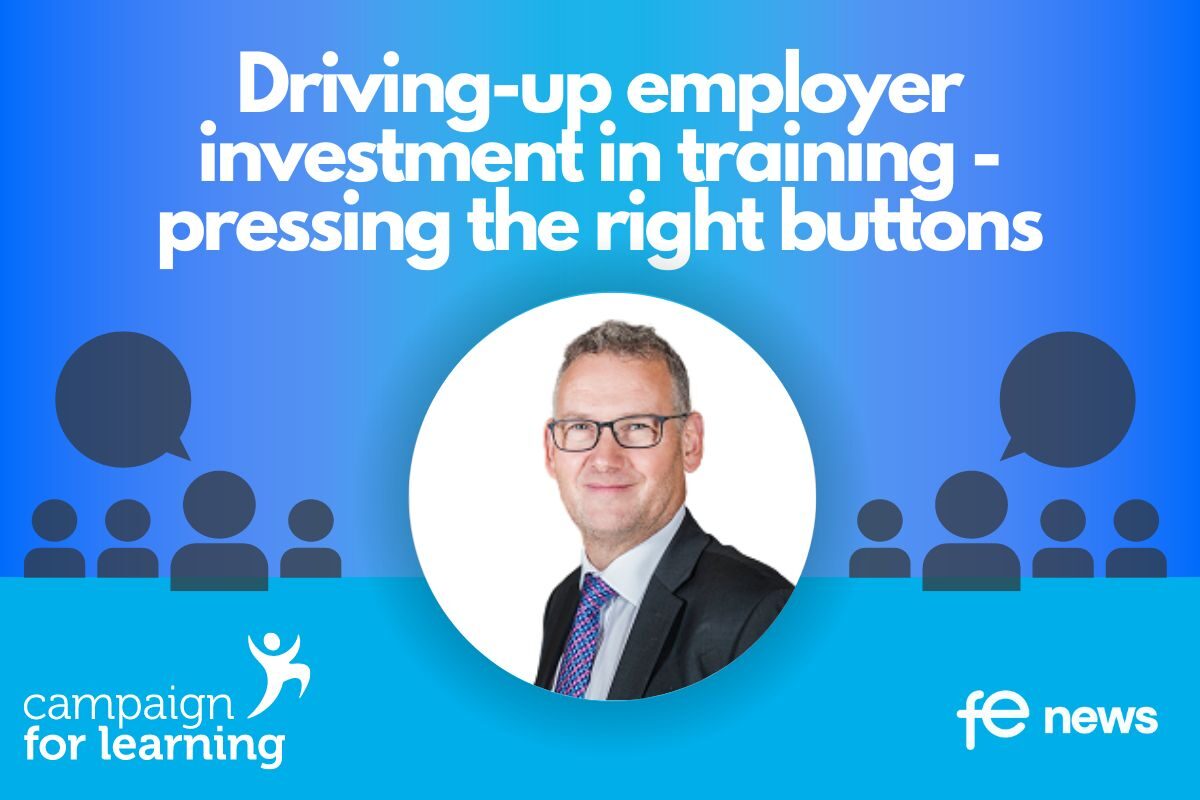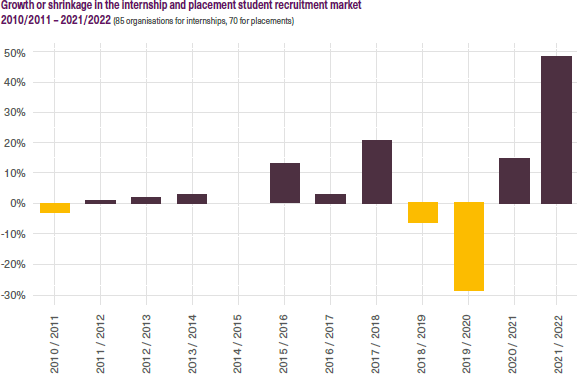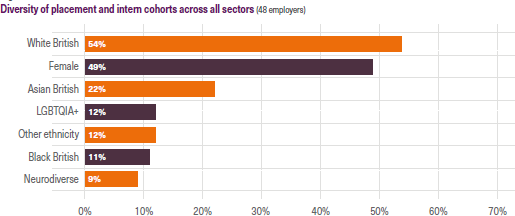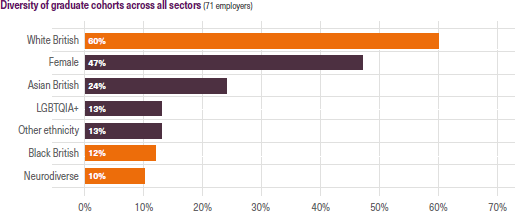Increasing employer demand for undergraduate work placements in England

Only the financial crash and Covid-19 dented employers’ appetite for internships, placements and other short-term programmes (Figure 1). In the long-run, employers have significantly increased the number of undergraduate work placement programmes they run. But why? Surely placements are expensive to manage, take up precious business time and clutter up the workplace with inexperienced and immature students.
Figure 1

Return on investment for work placements
There are four reasons employers continue to invest in placements.
Employers often hire placement students into full-time graduate positions. Assuming the hires are high caliber, the employer has reached and recruited a pool of talent ahead of their competitors. Our goal is “to secure talent as early as possible”, said one employer in a recent ISE survey.
Placement students make better hires than those without prior experience of the employer. When we asked ISE employer members about their hiring methods, the vast majority (64%) said that students who had completed a work experience placement arrived with better skills and attitudes compared to other students.
Placement cohorts are more diverse that graduate cohorts. Placement programmes often form part of an employer’s diversity strategy. Placement programmes give employers the opportunity to target students they historically struggle to attract and provide a route onto full-time graduate routes.
Placements students can enhance an employer’s brand. Those who have a good employment experience return to campus as brand ambassadors for their employer. But employers are also aware that students who have a bad placement experience can damage their brand – a bad programme is worse than no programme at all.
Work placement vacancies bounce back
Covid-19 did impact how many opportunities employers offered and how employers structured their programmes. This had two significant impacts on students. Firstly, because there was an overall decline in roles in 2020, a segment of students has not had the work experience they otherwise would have. Secondly, we have seen a longer-term shift to virtual or hybrid placements.
Levels of vacancies have bounced back significantly and are now at pre-pandemic levels (see Figure 1).
Some sectors have increased hiring more dramatically than others. Employers in the built environment sector increased vacancies by 47%, in the energy and engineering sector by 39%, and in the retail sector by31% in 2022 compared to 2021. No sector reduced hiring.
Hybrid programmes are here to stay
Over half (Figure 2) of placements are now hybrid – a mix of online and in-person working. The face-to-face internship has returned, but now accounts for only a third of programmes. Virtually delivered programmes have shrunk back to 12% from 72% in 2020.
Figure 2

Hybrid working in the broader labour market has probably altered the way placements are delivered for good. When compiling our most recent development report, we found that employers now see hybrid working as a skill they seek in all student hires. Hybrid programmes reflect the reality of working life and support placement students to develop in-person and online skills in a way that working solely in the office or from home can’t. Placements are a route to greater recruitment diversity.
Employers see placement programmes as an opportunity to target and work with students from diverse backgrounds. A third of ISE employer members offer programmes for specific diversity groups. As a result, placement cohorts are often more diverse than graduate recruitment intakes (Figures 3 and 4).
Figure 3

Figure 4

How to increase employer demand for placements
There are still far fewer placement vacancies than there are graduate vacancies. This will always be the case, as placements take resources to manage, and employers don’t always have work that suits the placement model. But in the interests of students and employers, we should maximise the number and quality of opportunities available.
Recommendation 1
Hybrid placements offer a greater flexibility in location and working patterns for students and the employer. New delivery mechanisms such as Forage’s pre-skilling approach are changing the way employers approach placement delivery. The University of York has been particularly successful setting up virtual internships.
Recommendation 2
The HE sector needs to educate more SME employers about work placements.
Recommendation 3
Employers and the HE sector need to work together to diversify placements.
By Stephen Isherwood, Joint Chief Executive, Institute of Student Employers
This article is part of Campaign for Learning’s series: ‘Driving-up employer investment in training – pressing the right buttons’.
Part One: Employer investment in context
- Louise Murphy, Economist, Resolution Foundation: Investment in the round
- Dr Vicki Belt, Deputy Director, Enterprise Research Centre, Warwick Business School: UK enterprises and investment in capital and training
- Becci Newton, Director, Public Policy Research, Institute of Employment Studies: Employer investment in training in England
Part Two: Drivers of employer investment in training
- Neil Carberry, Chief Executive, Recruitment and Employment Confederation: Derived demand, British management and employer investment in training
- Ewart Keep, Professor Emeritus, Education Department, University of Oxford: Strategies to drive-up employer investment in training
- Sam Alvis, Head of Economy, Green Alliance: Transitioning to net zero, green skills and employer investment in training
- Dan Lucy, Director of HR, Institute of Employment Studies: Job quality, job design and driving-up employer investment in training
- Natasha Waller, Policy Manager, LEP Network: Local inward investment, business support and employer demand for training
- Jovan Luzajic, Acting Assistant Director of Policy, Universities UK: Universities, R&D, business innovation and meeting employer skills needs
- David Hughes, Chief Executive, Association of Colleges: FE colleges, business innovation and meeting employer skills needs
Part Three: Increasing employer investment in training
- Paul Bivand, Labour Market Consultant: Why should employers invest in training in a flexible labour market?
- Aidan Relf, Skills Consultant: Why should employers invest in training with large net worker migration into the UK?
- Stephen Evans, Chief Executive, Learning and Work Institute: Raising employer investment in training
- Robert West, Head of Education and Skills, CBI: Increasing employer investment in training
- Lizzie Crowley, Skills Policy Adviser, CIPD: Encouraging employer demand for training
- Anthony Painter, Director and Daisy Hooper, Head of Policy and Innovation Chartered Management Institute: Increasing employer demand for management training
Part Four: Raising employer demand for publicly funded post-16 education and skills
- Jane Hickie, Chief Executive, AELP: Increasing employer demand for post-16 apprenticeships in England
- Mandy Crawford-Lee, Chief Executive, UVAC: Increasing employer demand for level 4-5 technical education in England
- Ian Pryce, Principal, The Bedford College Group: Increasing employer demand for higher technical education in England
Part Five: Raising employer demand for work placements
- John Widdowson, Board Member, NCG: Increasing employer demand for work placements for level 3-5 vocational courses in England
- Stephen Isherwood, Joint Chief Executive, Institute of Student Employers: Increasing employer demand for undergraduate work placements in England











Responses